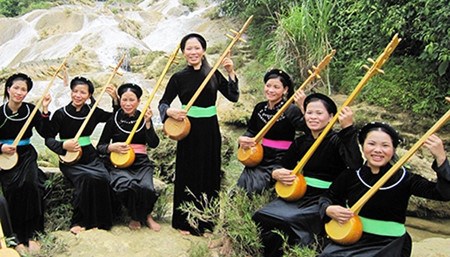Lai said that for many generations in Dinh Hoa area, Then singing has been a popular cultural practice in the community. People invited Then singer in various occasions from wedding, funeral, house-warming to even sickness because Then singing is believed to help connect people and the gods.
Then is an art with the combination of singing, dancing, instrumental music, narration and play. Then melodies differ in different occasions depending on the purpose of the event. Apart from ritual significance, Then singing is also staged as an public art and a kind of entertainment.
Through time, some initial purposes of Then singing such as fortune telling and disease treatment have become lost in oblivion, but other types of Then performances praying for peace and bumper crop still attract many people.
    |
 |
|
Photo for illustration. Source: VOV |
Then songs with new lyrics such as “Hoi xuan que noong” (spring festival in my hometown), “Viet Bac que em” (Viet Bac, my homeland), and “Trang soi duong Bac” (the moon lights Uncle Ho’s path), have earned popularity among younger generations, and have been regularly performed at art exchanges not only in Thai Nguyen but other localities.
With his love for the art, since 2000 when Then singing started to recover in the locality, Lai has taught the art to his children, while travelling to other neighboring localities such as Bao Linh, Dinh Bien, Dong Thinh, Kim Phuong, Tan Duong, Quy Ky and Lam Vy for teaching.
So far, the number of his students has mounted to hundreds, many of whom have become key players in Then singing movements in Dinh Hoa, Phu Luong districts and Thai Nguyen city.
Along with preserving and popularizing unique Then songs, Lai has also been famous for making gourd lute, called Dan Tinh or Tinh Tau, which is indispensable to Then singing. Each year, he makes from 150-300 gourd lutes.
According to the Literature and Art Association of Dinh Hoa, currently, 18 Then singing clubs have been formed in 24 communes and towns of the district, drawing about 200 singers and 500 trainees.
Suitable solutions needed to preserve the art
Currently, Then singing has become a typical folk art of Thai Nguyen with high historical, artistic and scientific values. However, like many other folk arts, Then singing is facing a risk of falling into oblivion.
According to the provincial Cultural Centre, 70 percent of Then singing artisan and gourd lute players in the locality are 60 years old and above, while groups of Then guiders are becoming fewer. Meanwhile, youngsters normally consider the art as a kind of entertainment, leading to a risk of losing ritual Then singing.
Therefore, along with supporting old artisans, it is necessary to focus more on training successive generations. Local governments in districts and cities should create more “playground” for Then singers, thus popularizing the art among community in a sustainable manner, especially among younger generations. The introduction of the art to schools is also a good idea.
Pham Thai Hanh, Director of the provincial Department of Culture, Sports and Tourism said that over the past years, the province has applied a number of measures to preserve and develop the traditional art.
Then singing practices have been revived in many festivals and events, while Then singing clubs have been set up in localities with large number of Tay and Nung people.
The collection and protecting of folk Then melodies have been implemented with the recording of 15 melodies and gourd lute playing techniques of 15 artisans in the province. Masters of Then have also been honored, said Hanh.
He added that in the coming time, the province will pay greater attention to promoting Then singing and gourd lute by maintaining the operation of the clubs, designing support policies for those who exerting efforts in keeping the art, and investing more in publishing Then song collections to maintain the art among generations and ethnic communities in the province.
Source: VNA